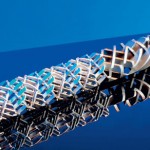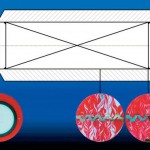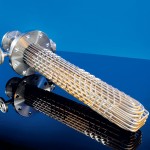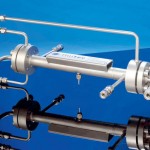In its day, it was the epitome of reliability. After leaving the conveyor belt, the VW Beetle ran like a Swiss watch. In that respect, it had a lot in common with static mixing and heat exchanger systems. Once installed in the process, they not only help save energy in complex applications, they also make the process safer. The very high space/time yield and the ability to operate continuously are key contributors to the growing popularity of this versatile apparatus group.
Alain Georg, Martin B. Däscher
The heart of a static mixer or mixer/heat exchanger are the fixed, geometrically shaped elements that mix the product flowing through them with the help of kinetic energy only. Whereas low-viscosity media are normally mixed by flow induced convection and vortex formation (Re > 2300), under laminar flow conditions homogenisation has to be achieved by actively separating and recombining the media (i.e. by turning it over), selective radial displacement and shear forces. The typical high radial mixing efficiency of static mixers and mixer/heat exchangers permits a continuous, controlled flow to the internal, axially arranged heat exchanger tubes. The energy demand arising from the pressure loss is reduced to a minimum by optimising the mixer geometries and sizing.
The term “energy efficiency” should not be restricted to what goes on inside the tube, however: a much broader definition is needed here to reflect the current importance of this global topic. Thanks to their uncomplicated and compact design, static mixer and mixer/heat exchanger systems are also extremely energy-economical to manufacture and install (grey energy). Since the reactors have no moving parts, the costs for operation and maintenance are comparatively low: as a rule, neither static mixers nor mixer/heat exchangers contain any parts subject to wear.
Static mixers and mixer/heat exchangers are used almost exclusively in continuous processes. Once they get going, this technology offers several crucial benefits, such as constant production conditions, no dead times, amenability to process automation and fewer personnel. It additionally impresses with its unusually high space/time yield, smaller volumes leading to reduced infrastructure and improved reaction control. All these factors make a substantial direct or indirect contribution to low-energy production.
The mixing and dispersion processes in classic agitators and high-speed rotor/stator systems typically exhibit significant local variations between specific energy dissipation fields. Most of the effective mixing and dispersion energy is output on the agitator blade tips or in the narrow gap between the rotor and stator, while the (more or less ineffective) energy in the much larger remainder of the container volume is lost. Static mixers, by contrast, have no dead zones. Providing the optimum mixer geometry is selected, energy is dissipated extremely homogeneously over both the length and the cross-section. This results in the very narrow particle size distribution for which the technology is renowned.
The local stress and shear fields that occur in static mixers are mainly responsible for the drop breakup. These effects have been demonstrated, characterised and optimised with the help of CFD simulations and laboratory tests. Almost the entire invested (pump) energy is consequently converted into an effective mixing and dispersion action.
Efficient heat transfer
Temperature conditioning of highly viscous substances on an industrial scale is often a very complicated process step. The efficiency of the energy transfer during the cooling process can easily be impaired to a considerable degree by stationary films with a high viscosity on the cooling tubes. The use of dynamic systems has the disadvantage that an unnecessary amount of thermal energy is input due to mechanical friction.
The CSE-XR mixer/heat exchanger combines the radial mixing efficiency of static mixers with the large heat exchanging area of multitube heat exchangers. However, the fact that the medium to be cooled flows in the outer shell of the parallel cooling tubes, to which it is continuously guided by the mixing elements in a controlled way, results in a much lower risk of maldistribution or stationary films with an insulating effect. The cooling circuit can therefore be operated at lower temperatures, so that the reactors are comparatively small and the residence time is shorter.
The heat and mass transfer distance needs to be kept as short as possible, particularly in the interests of optimal reactor operation, in order to avoid not only large temperature gradients but also degradation reactions and unwanted by-products. Safety is also greatly improved as a result of the reduced reactor volume. However, this is conditional on a meticulous heat exchanger design that takes account of various additional criteria. Detailed design principles exist to facilitate a precise prediction of the temperature profile of exo-thermic reactions in both the radial and longitudinal directions of the mixer/heat exchanger.
Thanks to the optimised heat transfer, the CSE-XR mixer/heat exchanger – meanwhile in the third generation – is firstly shorter and secondly suitable for combining unit operations such as very intensive mixing with high heat or mass transfer rates. Its heat transfer and mixing performance have been significantly improved by increasing the number of mixing bars: according to measurements and CFD calculations, the figure can be anything between 30 and 50 %. These features are directly responsible for the reduction in energy consumption and the ability to unite different chemical processes, such as mixing and simultaneous temperature conditioning of two highly viscous fluids. The required relative lengths, namely L/D = 4 to 15, enable a considerable quantity of heat to be supplied or removed. More and more customers are choosing the CSE-XR mixer/heat exchanger for chemical reactions such as esterifications or mass, emulsion and dispersion polymerisations for this reason.
Typical applications
Static mixers and mixer/heat exchangers are notable for their low-energy operation in a wide range of processes. When it comes to cooling viscous substances, they can take the place of multitube heat exchangers, the cold storage room or dynamic systems such as continuous tubular reactors and cooling extruders. They heat these substances efficiently because they provide a very high heat transfer capacity in a small volume. Compounding polymers in a static mixer rather than in an extruder results in a massive energy saving, higher product quality and reduced operating and maintenance costs. Since static mixers have perfect self-cleaning efficiency, colour changes are completed very quickly and degradation reactions virtually eliminated.
Mini-production plant systems enable continuous processes to be developed rapidly and simply in the lab. Mixing and reaction processes are hence more efficient, safer and more economical. Dangerous reactions such as nitrations, diazotisations, esterifications, complete polymerisations, etc. have already been successfully implemented in this way up to industrial scale.
The turn-over rates of multiphase systems are usually limited by the mass transfer rate. It is important not simply to create a large specific interface by means of dispersion, but also to ensure that the stationary films which limit the mass transfer by diffusion remain as thin as possible through continuous mixing. Static mixers provide the ideal answer.
cpp 435
More information about the products
Virtual exhibition for mixers, agitators and kneaders
Share:










